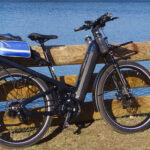My electric bike whispers a tune, a subtle hum emanating from its compact motor. It’s a sound I’ve grown to adore – a melody of tranquility and wonder. Can any amount of money truly buy as much pure joy as an electric bike delivers?
My first encounter with an electric bike was nearly a decade ago in Kyoto. The rental bike was bulky and heavy, yet the gentle push from its motor was unforgettable. As I tackled a hill, it felt like a friendly giant had placed a hand on my back, propelling me forward. That wide, silly grin hasn’t left my face since.
Fast forward two years, and another electric bike rental – this time, lighter, nimbler, and with a more potent motor. I was hooked. This was the future of cycling. Eighteen months later, amidst the global pandemic, I took the plunge and bought my first electric bike. There’s been no looking back.
Picture this: a perfect summer afternoon, gliding along the coast, the vast ocean stretching out on one side, a line of mature pine trees on the other. The sun is warm, yet a refreshing coolness prevails. There’s an almost irrational, deeply emotional thrill in the sheer efficiency of this unassuming machine beneath me. The motor, a small black cylinder at the wheel’s hub, seems too tiny to be so effective. Yet, it propels me forward, singing its quiet song – a beautiful, subtle hum. It ignites a desire to ride endlessly, to cover distances that seem almost absurd. The destination becomes secondary; the journey, this smooth, almost silent glide through the world, is everything. The gentle whir of the motor, the whisper of tires on asphalt, the wind in my ears, the crashing waves, the salty air, the scent of pine – these are the elements that electric bikes weave together, driving you delightfully mad with the simple poetry of existence.
A History of Bikes
Cycling has been a constant in my life. As a child, I rode a basic Huffy until it was worn out, eventually upgrading to a Haro Group 1. As an adult, bikes became a cherished indulgence. Over the last two decades, I’ve owned around fifteen bikes. From sleek aluminum and carbon Bianchi road bikes to elegant steel Kalavinka keirin bikes, each with its unique charm. I’ve explored cities on practical Dahon and Birdy BD-1 folding bikes. I’ve even embraced the humble mamachari – Japanese shopping bikes – finding their own kind of durability and fun, each meeting its end in a distinctive way. I sought out a custom Arrow cruiser, handcrafted by a builder in Ogikubo. And I still treasure a custom orange Moulton, transformed into a fast single-speed city bike, its small wheels and suspension offering a unique ride.
Bike after bike – why this obsession? Any cycling enthusiast understands: to fall for bikes is to crave more bikes. Each new bike is a fresh start, a rediscovery of riding. Exploring a city on a mamachari is a different experience than on a BD-1 or a Moulton – each thrilling in its own right. The bikes evolve, and so does your connection with the road. My bike love is all-encompassing; if it has two wheels and pedals, I’m intrigued. I want to experience them all.
Summers in Japan have always been challenging. The intense heat and humidity are oppressive. Bicycles have always offered a respite. Even with minimal effort, a bike creates a personal microclimate. While standing still might leave you drenched in sweat, riding a bike brings a refreshing breeze, keeping you noticeably drier and cooler. An electric bike simply amplifies this effect, making summer rides even more enjoyable.
As a child, I fantasized about having a personal helicopter, powered by my own pedaling and a touch of magic. I imagined silently soaring above the city, gliding effortlessly from home to the video store to a friend’s place. An electric bike captures much of that feeling.
In the past year and a half, I’ve clocked thousands of kilometers on my electric bikes. It often feels like the best kind of cheating. Living in a coastal town south of Tokyo, traffic congestion is a constant issue, the roads designed for a bygone era. The electric bike effortlessly navigates through the gridlock. Being stuck behind a gas-powered scooter now feels like observing an outdated, inefficient machine – noisy, cumbersome, and polluting. And often, not even faster or more practical than an electric bike.
The Electric Revolution
I currently own two electric bikes. My first was the BESV PSA1, a 20-inch wheel, rear-wheel drive model with customizable components. Later, captivated by the BESV’s charm and eager for more electric bike experiences, I added a front-wheel drive Vanmoof X3 to my collection.
Both bikes, while loved, have their quirks. The BESV’s electronics are basic. Settings reset every time it’s powered on, and the acceleration can be abrupt. The app is poorly designed and almost useless. Yet, despite these flaws, I rode it constantly in the first month. Its suspension smooths out any road, even dirt trails, inviting exploration of paths I’d never considered before. Suddenly, every hill becomes an invitation to climb.
Guests at my studio often borrow the BESV. It never fails to impress. One friend was so taken with it, they patted it affectionately upon dismounting, praising it like a loyal companion.
The Vanmoof is more sophisticated, with refined software and a user-friendly app. However, its custom components aren’t top-tier. The automatic shifting malfunctioned twice early on, requiring repairs. A seat post bolt broke. The original pedals felt flimsy. The stiff aluminum frame can be jarring on rough roads. More critically, the bottom bracket is dangerously low. Despite owning numerous bikes, I’d never experienced pedal strike until the Vanmoof. It’s happened dozens of times, once causing a crash when a pedal hit the pavement mid-turn. I’ve adapted my riding style, avoiding pedaling in turns and being hyper-aware of road slopes. But despite these issues, I’m still drawn to this bike. It sings its joyful hum, making me happy to be riding.
I’ve written about electric bike rides for Papersky Magazine, exploring Misaki, Oiso, and Yokosuka. And here’s a secret: Often at midnight, I’m compelled to ride. I take an electric bike out into the quiet streets, humming through the town, visiting temples in peaceful silence. The absence of cars and people creates an almost illicit feeling – slipping into temple grounds under the cloak of night, admiring the ancient architecture, feeling like a child, grateful for the moment.
I’ve long believed that universal bike ownership could promote world peace. Now, I envision everyone on electric bikes. I want everyone to experience this joyful silliness, this sense of freedom and delight. Humans at their worst are destructive, but at their best, they create things like electric bikes. Battery and motor technology has advanced rapidly, making these machines incredibly efficient. Electric bike popularity is surging. Those who know, advocate. The appeal is undeniable. The more people who discover electric bikes, the better the world. It’s a powerful idea – accessing goodness with no real downside. Like solar panels and wind turbines, electric bikes uplift both spirits and the planet.
Invest in the best electric bike you can afford. Spending more usually means a lighter frame, a more powerful motor, and longer battery life. Top speeds vary by location; in Japan, it’s capped at 24km/h, while in America, it’s 32km/h. Some regions allow only pedal-assist, while others permit throttles, blurring the lines with scooters. Regulations will evolve as electric bike adoption grows and cities adapt. This is just the beginning. A decade ago, electric bikes were rare in Tokyo. Today, they’re commonplace, especially for parents transporting children.
A good approach is to visit a local bike shop and test ride various electric bikes. Experience front-hub, rear-hub, and mid-drive motors to feel the subtle differences. Front-motor bikes might slip on hills, but feel like they’re pulling you forward on flat surfaces.
Electric bikes aren’t cheap, but they are a worthwhile investment. Despite minor flaws, occasional software issues, or imperfect geometry, they expand your world. They bring the nearby world closer, enriching your life in ways you might underestimate. These bikes sing their quiet songs, and the smile they bring to your face is the mark of a happy, perhaps slightly foolish, individual – and what a wonderful fool to be.
A summer night ride home along the river. The air is heavy with humidity, cicadas buzz in the distance, and the moon shines brightly. The choice: a direct route home along the moonlit river, or a detour into the dark mountains, doubling the distance. Almost always, I choose the mountains. More! yells that inner child. More of this feeling. And so, fueled by the electric bike, I venture into the shadows, climbing, propelled by that unseen hand, always ready to assist. It’s a wonderful paradox, a thing of peace and magic. An owl calls. The smile remains.
This essay was originally published in September 2022.
By Craig Mod, writer and photographer based in Japan. Author of Things Become Other Things and Kissa by Kissa. His work has appeared in The New York Times, Eater, The Atlantic, and more. He publishes newsletters: Roden & Ridgeline. His work is supported by memberships and book sales. Find him (but maybe don’t follow) on Bluesky or Instagram.


